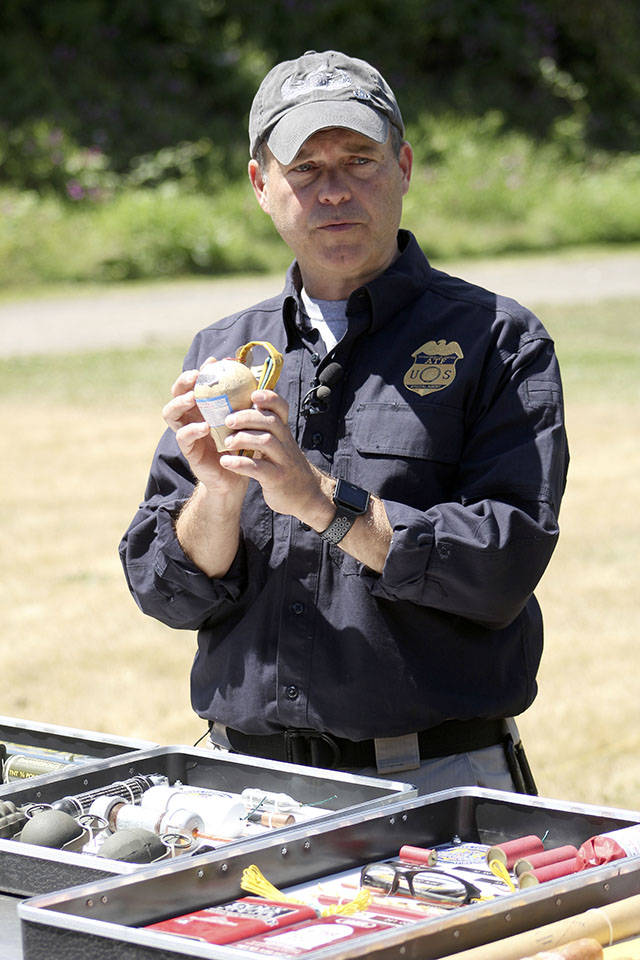A lot can go wrong with fireworks around the Fourth of July, and the Bureau of Alcohol, Tobacco, Firearms and Explosives recently showed the media just how sideways a celebration can go.
On June 26, the Bureau and a state Fire Marshall held a press conference about legal fireworks, illegal fireworks, and firework safety to head off potential injuries that happen around the Fourth of July.
According to the State Fire Marshal’s Office, there were 345 reports of firework-related incidents in 2017; 262 injuries and 83 fires.
However, only 53 injuries and six fires were caused by illegal fireworks; the rest were caused by what are considered “safe and sane” consumer fireworks, Deputy State Fire Marshal Lysandra Davis said at the event.
“Be prepared, be safe, and be responsible,” Davis continued, listing off some easy tips you can use to be as safe as possible around fireworks, like making sure there’s a bucket of water nearby, never lighting fireworks close to buildings or trees, never trying to re-light a dud firework, use safety goggles, and don’t drink and light fireworks (have a “designated lighter”).
Still, between 7,000 and 11,000 injuries have been reported nationally every year since 1978, according to the American Pyrotechnics Association, and there’s little reason to expect Independence Day 2018 to be any different.
To help inform Washingtonians of the right choices when purchasing and lighting fireworks, Bureau Certified Bomb Technician Brennan Phillips demonstrated how destructive even the smallest of illegal fireworks can be by strapping some to wooden figures out at the Seattle Police Athletic Association.
“We have a unique problem here, and that’s the carnage that is incurred by flash powder devices,” Brennan said, showing off a few illegal devices that are prevalent in the state before being lit.
The first was called a “triangle cracker,” which looked like a brown origami triangle with a short fuse. The only label on it said, “Made in China,” which is a good indication it’s an illegal firework, Phillips said.
“It’s completely contraband, but being sold like a consumer firework would be,” he continued, adding they are typically filled with three or four grams of flash powder.
When Phillips attempted to light the cracker, it didn’t take — but the next firework, a Chinese firecracker, also had several grams of flash powder in it, “enough to take your fingers off,” Phillips said.
Moving onto the bigger items, Phillips brought out a “Silver Salute” and a tennis ball bomb, devices that are packed with enough flash powder to take off a limb of a wooden dummy, and probably a person, too.
But the showstopper wasn’t an illegal device at all, but a professional 3-inch “Arial Salute,” which isn’t intended for consumer use.
“In the wrong hands, this can be deadly,” Phillips said, pointing out some of the reasons why untrained users can be caught unawares by the firework.
This particular firework has an “instantaneous fuse,” which many people think is a longer fuse for delayed lighting, Phillips said.
“When someone lights this, it lights the lift charge — which is designed to shoots the it up in the air — and just a few seconds later, you get the shell,” Phillips said. “[If] you think this is a long-burning fuse and you light it, you’re sorely mistaken. What’s happened here a few times is, it lights, that lift charge goes off, kicks the shell charge back toward the individual, they go to kick it away or batter it away, it goes off, and removes an arm or a leg.”
In once case, a user in the Fargo, North Dakota area was decapitated by this sort of firework in 2011, Phillips said.
Phillips said he condones the safe use of legal fireworks, but asks everyone to stay away from the illegal ones.
“It’s easy to tell what the illegal stuff is — it costs a lot of money, and it’s hard to get,” he said. “It’s not hard to stay away from it, and the consequences for using it, you could be running into a felony from the federal government and your state government, loss of eyes, limbs, arm, fingers, even life. It’s not worth it.”
The King County Sheriff’s Office is preparing to have increased patrols around July 4, emphasizing city residents should follow their local ordinances when lighting fireworks and reminding unincorporated King County residents that fireworks are only able to be lit legally between 9 a.m. and midnight on the holiday.


